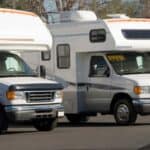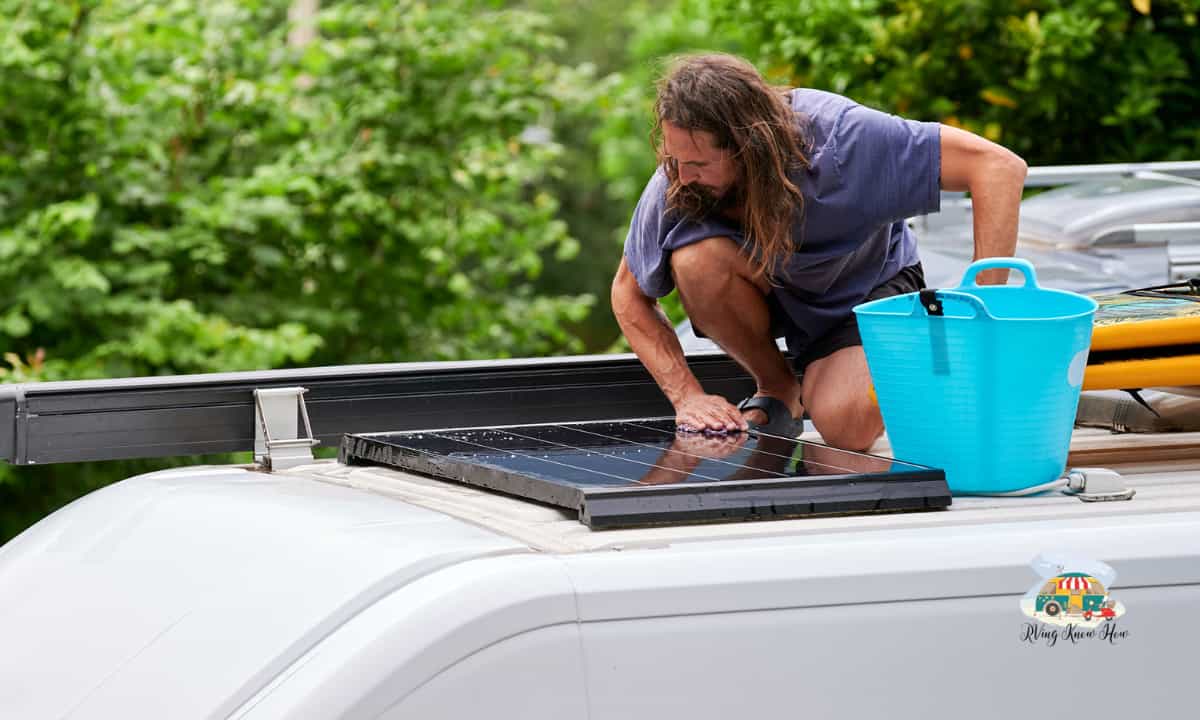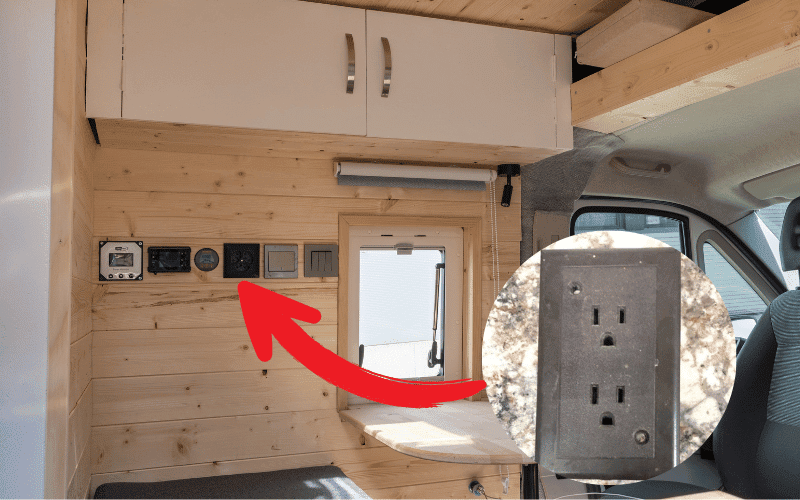Today’s modern RVs are being equipped with all sorts of new bells and whistles that will constantly draw power from your RVs battery when connected but not in use. Especially when stored for long periods or making any electrical repairs. With the constant draw of electricity, it can hinder the batteries longevity.
And that’s where An RV battery disconnect switch comes into the help.
An RV battery disconnect switch is the most cost effective and easier to integrate solution for cutting off the electrical power to a circuit temporarily without manually disconnect your RV battery bank.
Not only it will to extend your battery life It’s also help protect your camper against electrical fires and theft when equipment is not in use.
In this article we will discuss what does an RV battery disconnect switch do, how and when to use them, and importance of having a battery disconnect switch on your camper.
What Is an RV Battery Disconnect Switch and What Does It Do?
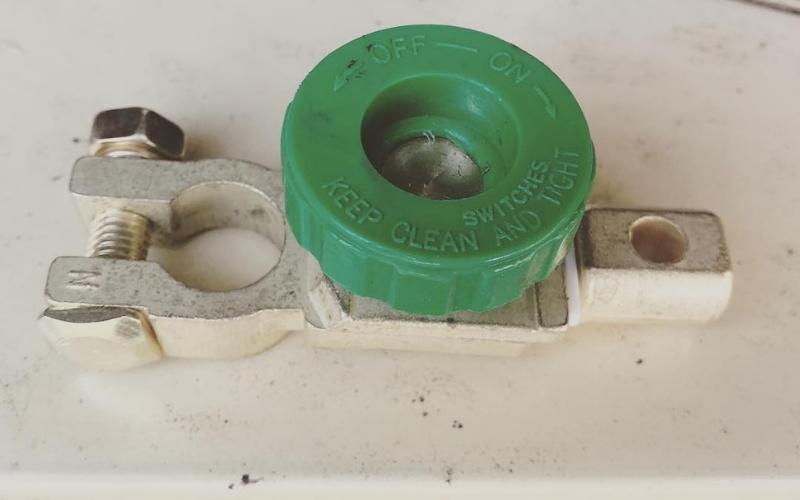
An RV battery disconnect switch is a piece of equipment that stops power flow from your coach batteries to the cabin of your RV.
You will find this battery disconnect switch in different locations on RVs depending on the model. Most commonly, the switch is located on a control panel inside the RV.
On my old Fleetwood Bounder, for example, it was above and to the left of the entrance on a control panel that also included indicators for my RV’s holding tanks.
In other cases, however, you may find the disconnect switch for your RV battery inside the battery compartment itself.
Knowing where your switch is located on your RV is important for certain storage and maintenance tasks.
Why is an RV Battery Disconnect Switch Important?
The main reason that RVs are built with battery disconnect switches is to protect RV owners and mechanics when they are performing maintenance and repairs.
But your disconnect switch also helps to maintain the health and increase the longevity of your batteries themselves.
Furthermore, your battery disconnect is extremely important in case of an emergency.
If something like an electrical fire starts unexpectedly in your RV, you may only have minutes to find and flip your battery disconnect switch to prevent permanent and catastrophic damage.
How Does Battery Disconnect Switch Work on RV?
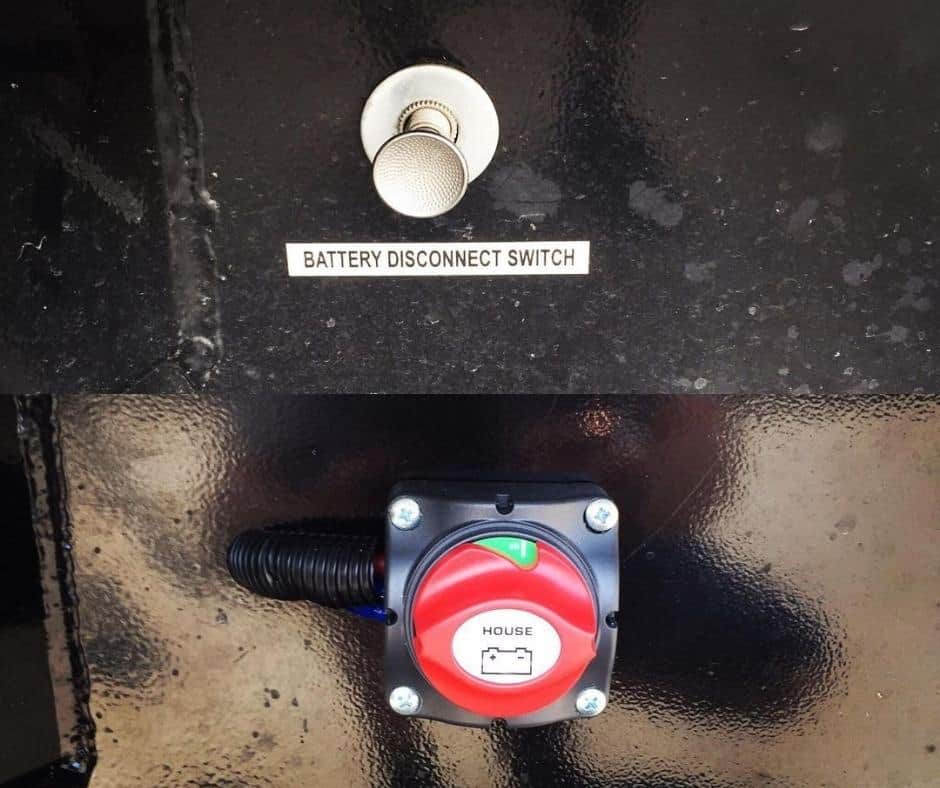
All RV batteries can be disconnected manually. This process requires opening the hood or engine cover and removing the cable (or cables) connected to the negative battery terminal (or terminals) inside your battery compartment.
This process can be cumbersome and downright inefficient for certain procedures.
It can also be dangerous if done improperly and can lead to unnecessary wear on the battery cable and the terminal itself.
An RV battery disconnect switch works by disrupting the flow of power from your battery bank to the rest of your RV. Instead of having a single cable running from your negative battery terminal, you will have two cables with the “switch” in between.
When the switch is activated, these two cables are disconnected so that power can not flow between them.
When the switch is deactivated, the two cables will come into contact again and allow for power to flow to the lights and appliances in your RV’s cabin and underneath compartments.
When Should You Use the RV Battery Cutoff Switch?
There are two main times when you will employ the use of your RV battery cutoff switch: when you are prepping your RV for seasonal storage and when you (or someone else) are getting ready to complete maintenance tasks.
Let’s touch a little more on each of these reasons for engaging your cutoff switch.
Getting Your RV Ready For Storage
If you are going to store your RV without plugging it into a source of shore power, it is wise to engage your battery disconnect switch.
This will eliminate the likelihood of appliances draining your battery while you aren’t actively monitoring its levels.
Even if you unplug all of your RV appliances while your rig is in storage, they can draw a small charge that will drain your battery.
This becomes a nuisance when you get back into your RV to prep for your next trip and find that your batteries are dead.
RV batteries also naturally lose a small portion of their charge over time when they are disconnected.
This is why many RV owners will actually manually disconnect and move their batteries into a garage or more climate-controlled area while their rig is in storage.
Storing your batteries in an area that isn’t subject to extreme temperatures will reduce the amount of charge loss and also make it easier for you to hook the batteries up to a trickle charger to keep them fully charged and ready to go when you start prepping your rig for your next trip.
Completing Routine or Emergency Maintenance
Engaging your disconnect switch is also essential before performing both routine and emergency RV maintenance tasks.
When you need to cut power to your RV freezer to thaw it out and remove excessive ice buildup, for example, it is much easier to flip a switch than to unplug your refrigerator and freezer unit entirely.
This is also an important step if you ever have to do any emergency maintenance on your RV’s electrical system, service A/C units, or replace certain mechanical components like an air compressor or drive belt.
To put it as simply as possible, you need to ensure that there is absolutely no chance of electrocution before you attempt routine or emergency RV maintenance. And engaging your battery disconnect switch is the best way to do that.
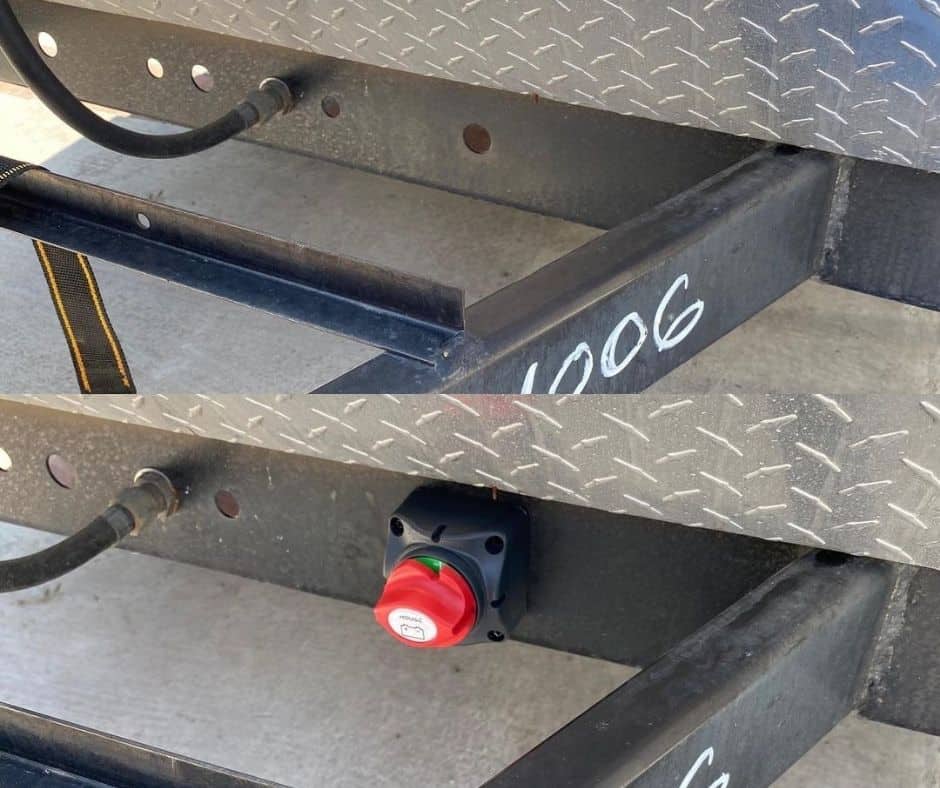
How Do You Install an RV Battery Cutoff Switch?
Like everything on your RV or travel trailer, the cutoff switch for your RV battery has a finite lifespan.
If it wears out and no longer does its job effectively, replacing it should become a top priority and you will need to know how to find and install a new model.
If you have come to the conclusion that your disconnect switch is faulty, here is a brief overview of the steps you will need to take to install a new switch:
Find a Compatible Replacement Switch
The first (and sometimes hardest) step in this process will be finding a replacement switch that is compatible with your RV model.
Fortunately, your owner’s manual should have detailed specifications for the original manufacturer of the switch.
If you are having trouble locating this information in your owner’s manual, you can also call the manufacturer directly or call up an RV electrical technician to seek a professional opinion.
Manually Disconnect Your RV Batteries
If your old switch was installed on the negative cable to your batteries, you will only need to disconnect the negative lead to stop the flow of power through the cable.
If your old switch was installed on the positive lead, however, we recommend disconnecting the cables from both battery terminals before proceeding.
Remove The Old Switch
Next, you will need to remove your old switch by detaching the cable ends that are running from your battery into the switch and then to your RV cabin, respectively.
This will leave you with two ends of copper wiring that you will then connect to your new switch.
This, of course, assumes that your RV was already equipped with a cutoff switch and you aren’t installing one for the first time.
If the latter is the case, you will need to cut your battery cable in a convenient spot and then strip back some of the protective exterior coating in order to expose enough cable to make the installation of your switch possible.
Install The New Switch
We recommend installing the disconnect switch on the negative cable leading to your batteries.
Some manufacturers have the switch installed on the positive lead, but the negative side is the safest bet.
That is because leaving the negative cable connected when you disconnect the positive lead can cause a short circuit if the positive lead accidentally makes contact with the RV frame.
While this is unlikely when the end of the positive lead is still connected to the terminal, you can never quite know when things have shifted in your RV’s engine compartment while you were driving.
That being said, you will most likely need to replace the existing switch according to the current configuration on your RV.
If your old switch was installed on the positive lead, you will have to work with that and you should be careful to make sure both leads are disconnected before you remove the old and install the new switch.
Most new switches come with mounting holes so that they can be permanently installed inside your battery bay or compartment.
You don’t want your switch just dangling loosely underneath your RV because that is going to put unnecessary strain on the connection points and make a loose or faulty connection more likely.
Reconnect The Batteries
Once you have your new switch mounted and solid wiring connection points made and insulated, it is time to reconnect the battery cables and test your work.
Be aware of the position that your switch is in before you connect the battery cables.
If you leave your switch disengaged (i.e. off), your RV appliances should have DC power as soon as you reconnect the positive and then negative leads to your batteries.
If your switch is engaged (i.e. on) when you connect the leads, you will not have power in your RV cabin until the switch is disengaged.
Many owners recommend reconnecting the leads with the switch engaged. This will help to eliminate a power surge causing damage to your appliances.
You can then use a multimeter to test that you have power to your switch before you close the circuit and perform a final test by checking your RV appliances.
Best RV Battery Disconnect Switches
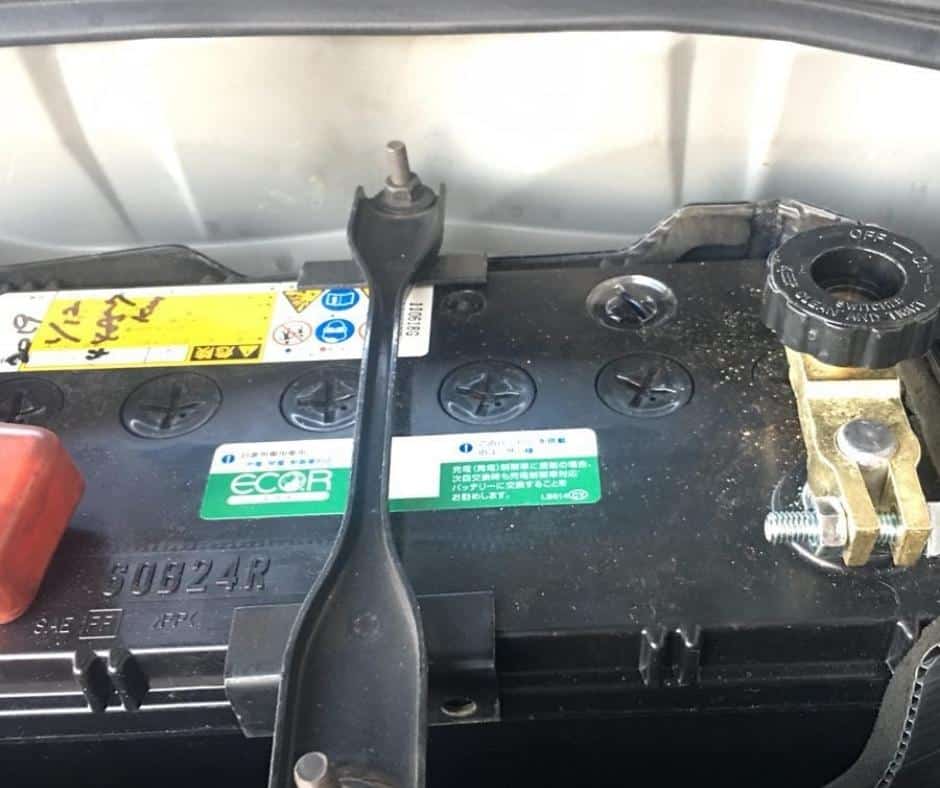
For those of you that have found out that your switch is faulty and needs to be replaced, we have compiled a few of the best replacement models for you to choose from.
1: Nilight – 90015A Waterproof Battery Power Disconnect Switch
The Nilight battery cutoff switch offers a two-year life expectancy and works with a maximum operating voltage of 48 volts.
It features heavy-duty construction with an ABS plastic housing and a rear cover to insulation better against shorts.
This switch comes with four bolts and features pre-drilled mounting holes that make installation quick and easy.
It also can be used as a stand-alone switch or it can be locked together with a secondary switch.
2: GAMA Electronics BS200 Battery Master Disconnect Switch
This disconnect switch made by GAMA Electronics is designed to install right on the top post of your RV battery.
It features brass construction and is rated to withstand a maximum of 200 amps.
This switch is designed to be easily installed as a replacement for the existing clamp at the end of your negative battery lead.
It provides a secure connection and disconnecting your battery will then require the simple turn of a knob instead of the manual removal of the entire clamp.
3: Blue Sea Systems B01E53G7QI m-Series Battery Switches
The Blue Sea Systems cutoff switch is designed for a universal fit on all RVs, travel trailers, fifth wheels, and other types of recreational vehicles that require a disconnect switch.
It is rated to withstand a maximum of 300 continuous amps and up to 450 intermittent amps.
This is actually a dual-circuit disconnect switch that will enable you to connect two isolated battery banks.
It then features a ‘make-before-break design that allows you to seamlessly switch between battery banks without power interruption or disconnect both banks entirely as needed.
Conclusion
There are many mechanical maintenance tasks that require the power to but cut off to the appliances inside your RV.
Procedures for servicing your refrigerator, air conditioning unit, RV furnace, and other appliances all pretty much start with the all-important step of disconnecting the appliances from their power source.
Your RV battery disconnect switch makes servicing these appliances (and even your RV’s engine) much more efficient.
It eliminates the need to manually disconnect your RV battery to ensure your safety.
Still, it is a safe bet to test your RV battery disconnect switch on a regular basis.
It is better to be sure that it is working properly than to suffer the consequences of trying to service an appliance that still has electricity flowing into it.
We hope that you have learned a little bit about RV battery disconnect switches, why they are important, and how to use them properly in this article.
As always, we wish you the safest and most adventurous of upcoming RV travels!




